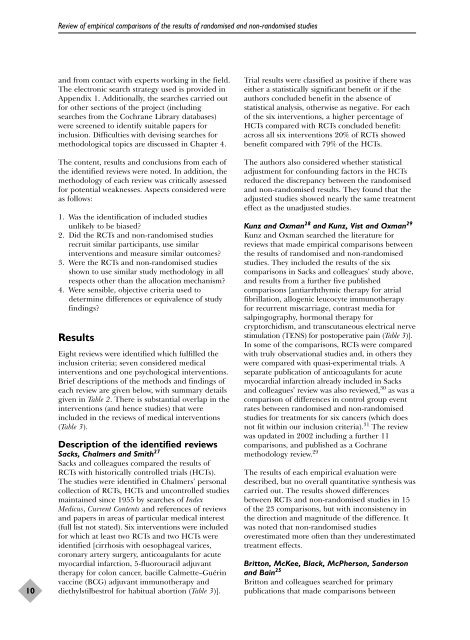Evaluating non-randomised intervention studies - NIHR Health ...
Evaluating non-randomised intervention studies - NIHR Health ...
Evaluating non-randomised intervention studies - NIHR Health ...
Create successful ePaper yourself
Turn your PDF publications into a flip-book with our unique Google optimized e-Paper software.
Review of empirical comparisons of the results of <strong>randomised</strong> and <strong>non</strong>-<strong>randomised</strong> <strong>studies</strong>10and from contact with experts working in the field.The electronic search strategy used is provided inAppendix 1. Additionally, the searches carried outfor other sections of the project (includingsearches from the Cochrane Library databases)were screened to identify suitable papers forinclusion. Difficulties with devising searches formethodological topics are discussed in Chapter 4.The content, results and conclusions from each ofthe identified reviews were noted. In addition, themethodology of each review was critically assessedfor potential weaknesses. Aspects considered wereas follows:1. Was the identification of included <strong>studies</strong>unlikely to be biased?2. Did the RCTs and <strong>non</strong>-<strong>randomised</strong> <strong>studies</strong>recruit similar participants, use similar<strong>intervention</strong>s and measure similar outcomes?3. Were the RCTs and <strong>non</strong>-<strong>randomised</strong> <strong>studies</strong>shown to use similar study methodology in allrespects other than the allocation mechanism?4. Were sensible, objective criteria used todetermine differences or equivalence of studyfindings?ResultsEight reviews were identified which fulfilled theinclusion criteria; seven considered medical<strong>intervention</strong>s and one psychological <strong>intervention</strong>s.Brief descriptions of the methods and findings ofeach review are given below, with summary detailsgiven in Table 2. There is substantial overlap in the<strong>intervention</strong>s (and hence <strong>studies</strong>) that wereincluded in the reviews of medical <strong>intervention</strong>s(Table 3).Description of the identified reviewsSacks, Chalmers and Smith 27Sacks and colleagues compared the results ofRCTs with historically controlled trials (HCTs).The <strong>studies</strong> were identified in Chalmers’ personalcollection of RCTs, HCTs and uncontrolled <strong>studies</strong>maintained since 1955 by searches of IndexMedicus, Current Contents and references of reviewsand papers in areas of particular medical interest(full list not stated). Six <strong>intervention</strong>s were includedfor which at least two RCTs and two HCTs wereidentified [cirrhosis with oesophageal varices,coronary artery surgery, anticoagulants for acutemyocardial infarction, 5-fluorouracil adjuvanttherapy for colon cancer, bacille Calmette–Guérinvaccine (BCG) adjuvant immunotherapy anddiethylstilbestrol for habitual abortion (Table 3)].Trial results were classified as positive if there waseither a statistically significant benefit or if theauthors concluded benefit in the absence ofstatistical analysis, otherwise as negative. For eachof the six <strong>intervention</strong>s, a higher percentage ofHCTs compared with RCTs concluded benefit:across all six <strong>intervention</strong>s 20% of RCTs showedbenefit compared with 79% of the HCTs.The authors also considered whether statisticaladjustment for confounding factors in the HCTsreduced the discrepancy between the <strong>randomised</strong>and <strong>non</strong>-<strong>randomised</strong> results. They found that theadjusted <strong>studies</strong> showed nearly the same treatmenteffect as the unadjusted <strong>studies</strong>.Kunz and Oxman 28 and Kunz, Vist and Oxman 29Kunz and Oxman searched the literature forreviews that made empirical comparisons betweenthe results of <strong>randomised</strong> and <strong>non</strong>-<strong>randomised</strong><strong>studies</strong>. They included the results of the sixcomparisons in Sacks and colleagues’ study above,and results from a further five publishedcomparisons [antiarrhthymic therapy for atrialfibrillation, allogenic leucocyte immunotherapyfor recurrent miscarriage, contrast media forsalpingography, hormonal therapy forcryptorchidism, and transcutaneous electrical nervestimulation (TENS) for postoperative pain (Table 3)].In some of the comparisons, RCTs were comparedwith truly observational <strong>studies</strong> and, in others theywere compared with quasi-experimental trials. Aseparate publication of anticoagulants for acutemyocardial infarction already included in Sacksand colleagues’ review was also reviewed, 30 as was acomparison of differences in control group eventrates between <strong>randomised</strong> and <strong>non</strong>-<strong>randomised</strong><strong>studies</strong> for treatments for six cancers (which doesnot fit within our inclusion criteria). 31 The reviewwas updated in 2002 including a further 11comparisons, and published as a Cochranemethodology review. 29The results of each empirical evaluation weredescribed, but no overall quantitative synthesis wascarried out. The results showed differencesbetween RCTs and <strong>non</strong>-<strong>randomised</strong> <strong>studies</strong> in 15of the 23 comparisons, but with inconsistency inthe direction and magnitude of the difference. Itwas noted that <strong>non</strong>-<strong>randomised</strong> <strong>studies</strong>overestimated more often than they underestimatedtreatment effects.Britton, McKee, Black, McPherson, Sandersonand Bain 25Britton and colleagues searched for primarypublications that made comparisons between
















